Here’s how your electric car battery will last longer
1. How do you maintain an EV battery in the long run?
There is no magic solution to completely prevent battery wear, but with proper care you can avoid many problems. How you charge your battery is especially important. Good charging behavior will make your battery last much longer. For example, invest in a home charging station so that you have control over the charging process and can use cheaper nighttime electricity.
Also, keep your car’s software up-to-date. Many manufacturers release updates that improve battery performance or add new features. Regular checks at the dealer or service partner can detect small problems before they have major consequences.
2. Limit the use of fast chargers
Fast charging is ideal if you are in a hurry or traveling long distances, but use it in moderation. Fast charging generates a lot of heat, which can be harmful to battery cells over time. Therefore, use fast chargers only in emergencies or during long road trips. For daily charging, a regular home charger or a public charging station is much better. With these, you charge your car at a slower rate, which is better for the health of the battery.

3. Consider temperature
Temperature plays an important role in the life of your battery. The ideal operating temperature of an EV battery is between 20 and 40°C. Extreme heat, for example temperatures of 50°C or higher, can cause permanent damage. If at all possible, don’t hang your car on the fast charger right after an intense drive, as the battery will already be warm and extra heat can be bad. Fortunately, many modern EVs have advanced temperature regulation systems that reduce the impact of extreme temperatures.
4. Choose a quiet driving style
A sporty driving style with rapid acceleration and hard braking demands a lot from the battery and can shorten its life. Most electric cars have an eco mode, which allows you to drive more efficiently and save energy. This way you don’t have to charge the battery as often. Try to use this eco mode as much as possible, especially in daily driving. Occasional sporty driving is no problem, but don’t overdo it.

5. Charge smart and avoid extreme charging modes
It may seem logical to always charge your battery fully or drive it completely empty, especially if you have to travel a long distance. After all, that’s what you do with a gasoline-powered car: you usually only stop by a gas station when the tank is almost empty. But with an EV, that’s not wise. For daily use, it is best to keep the charge level between 20 and 80%. Regularly dropping below 5% or constantly charging above 90% can cause the battery to wear out faster. Of course, it is no problem to fully charge the battery occasionally before a long drive, but don’t do this daily.
6. Park wisely
If you have the opportunity, park your car in a sheltered spot. A garage or covered parking lot helps protect the battery from extreme weather conditions. Direct exposure to bright sun or frost is not ideal. While not directly damaging to the battery, it can affect its performance and charge level. For example, a cold battery can charge much slower than one at room temperature. A little protection can make a lot of difference in the long run.

7. Drive regularly and avoid prolonged idling
Electric cars – like gasoline cars – are made for driving. Standstill is degradation. Is the car stationary for a longer period of time? Then make sure the charge level is between 50 and 75%. This prevents the battery from completely discharging or being unnecessarily charged during prolonged downtime. Regular driving keeps the battery active and in good condition.
Also see: Used Tesla Model 3s are bargain-basement, but what are the pitfalls?

